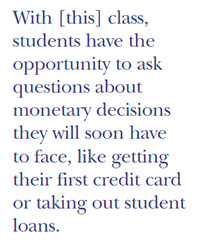
Last spring Allatoona High School joined a small group of public and private schools in the county that offer a personal finance class.
It’s a topic that hardly needs discussion, as many people have been affected by the current economic crisis, but now more than ever, money is a source of stress and worry. The Concord Coalition, a nonpartisan, grassroots organization dedicated to eliminating federal budget deficits, reported as recently as July that the country as a whole is more than $15 trillion in debt. Understanding money–not just how to save it, but also how to spend wisely and how to productively use credit cards–has become a topic that concerns all U.S. citizens, especially high school students who are about to begin college.
To fill the knowledge gap, last spring Allatoona High School joined a small group of public and private schools in the county that offer a personal finance class. Basketball coach Nicholas Estes taught about 50 seniors for two periods a day everything from how to balance a checkbook and effectively save money to how to avoid credit card debt. Teachers and administrators alike hope that it will catch on in the coming years.
The benefits of offering a finance class to high school students are numerous. First and foremost, it is a subject that appeals to all types of students no matter what career path they choose to follow. “The recent economic recession pointed out a number of flaws within our national economy, but it also revealed the challenges and problems that families throughout our community were facing on a very personal level,” explains Eric Bradley, principal of Mt. Paran Christian School, which has offered a Personal Finance class since 2008. “Our intent in creating the class was to provide students with a foundational knowledge of healthy financial practices and good stewardship … With the challenges of unemployment, heavy debt burdens and widespread foreclosures, it seemed like a logical step to provide a course that would enable students to practice healthy financial practices.” Estes is equally passionate about the course and its importance in students’ lives. He hopes that the class can soon be considered for credit, as it did not return with the start of the 2012-2013 school year. Currently, the course does not count toward graduation credits, meaning students take it as an elective. The Board of Regents did not accept it as a core math class because schools that do not employ block scheduling, like Allatoona, allow fewer credits to graduate. “The Board of Regents doesn’t approve the class as a class above Math III, so they won’t accept it as admittance to college, which makes no sense,” says Estes. “Because it’s not a class where kids could go to college, they’re not going to push it at the high school [level].”
The long-term effects of teaching students financial responsibility can already be felt. Recently, Estes spoke with a former student who took his class in the spring and then went to basic training for the Marines. “He told me because of the class he had $10,000 in savings, $3,800 in a Roth IRA, $6,000 in checking and he has zero debt. This young man is already better off than 95 percent of adults in this country.” The lessons also resonate with the parents of students who take the course. “The parents and students appreciate the practical aspect of the class, which incorporates lessons involving balancing a personal budget, managing a checking account and starting a small business,” says Bradley. “The most frequent comment I hear about the course from parents is ‘I wish I had taken a course like that when I was in school so I could have avoided some of the mistakes I made.’”
For Estes, it’s all about teaching kids wise financial decisions as they go on to higher learning or enter the working world. “If we start with our younger people we can change how our government operates and become more financially healthy. We talk about all those good financial things that will make you rock solid,” he says. “You can do what you want–you can be a teacher like me and never make $100,000 in a year by yourself but still retire with a decent amount of money. I do it because I want to help people before I get older.”
 With his class, students have the opportunity to ask questions about monetary decisions they will soon have to face, like getting their first credit card or taking out student loans. They are also faced with scenarios they may never have considered, such as potentially taking core college classes at a state school to save money. “If we boil it down to just our state or just our county, if people get sound financial principles then we would realize that we can actually do more with our money than we think we can do,” Estes explains. “It would relieve a lot of stress if you’re not living paycheck to paycheck. You don’t live with the stress of ‘What happens if I get laid off?’” Bradley describes the Mt. Paran course as an eye-opener for students when it comes to the realities of how quickly debt and everyday expenses can accumulate.
With his class, students have the opportunity to ask questions about monetary decisions they will soon have to face, like getting their first credit card or taking out student loans. They are also faced with scenarios they may never have considered, such as potentially taking core college classes at a state school to save money. “If we boil it down to just our state or just our county, if people get sound financial principles then we would realize that we can actually do more with our money than we think we can do,” Estes explains. “It would relieve a lot of stress if you’re not living paycheck to paycheck. You don’t live with the stress of ‘What happens if I get laid off?’” Bradley describes the Mt. Paran course as an eye-opener for students when it comes to the realities of how quickly debt and everyday expenses can accumulate.
Personal finance courses can also better connect students with material they learn in other classes. “Everybody’s going to have to make financial decisions,” says Estes. “I know that some of the guys at our school that teach economics do a good job of trying to teach some of those financial principles but they have a class that’s only taught for half a semester, they have lots of other things that they have to teach and there’s just too much–you need a class on this stuff.”
Allatoona students hope, as Estes does, that with the right support the class will be approved for credit in the near future and offered in all 16 of Cobb’s public high schools. “People are mad at the banks and they’re mad at the loan companies but the truth is we should be mad at ourselves for not being educated,” says Estes. “I don’t think anybody would disagree that our kids need it, but I think for change to happen we have to have enough people to stand up and say we want it.”










